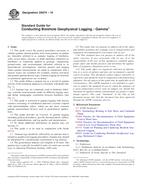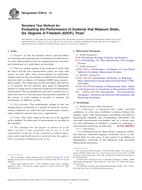Potřebujeme váš souhlas k využití jednotlivých dat, aby se vám mimo jiné mohly ukazovat informace týkající se vašich zájmů. Souhlas udělíte kliknutím na tlačítko „OK“.
ASTM D6274-10
Standard Guide for Conducting Borehole Geophysical Logging - Gamma
Automaticky přeložený název:
Standardní příručka pro dirigování vrty geofyzikální protokolování - Gamma
NORMA vydána dne 1.10.2010
Informace o normě:
Označení normy: ASTM D6274-10
Poznámka: NEPLATNÁ
Datum vydání normy: 1.10.2010
Kód zboží: NS-34479
Počet stran: 11
Přibližná hmotnost: 33 g (0.07 liber)
Země: Americká technická norma
Kategorie: Technické normy ASTM
Kategorie - podobné normy:
Anotace textu normy ASTM D6274-10 :
Keywords:
borehole geophysics, dead time correction, gamma log, natural gamma log, nuclear statistics, radioisotope, well construction, well logging: Access tubes, Borehole geophysical logging, Caissons, Dead time correction, Environmental site assessment (ESA)--soil/rock, Gamma logging, Geological investigations, Geotechnical engineering materials/processes, Ground water, Lithology, Natural gamma log, Radioisotopes, Site identification/investigation/selection, Stratigraphic correlation/description
Doplňující informace
| Significance and Use | ||||||||||
|
An appropriately developed, documented, and executed guide is essential for the proper collection and application of gamma logs. This guide is to be used in conjunction with Guide D5753. The benefits of its use include improving selection of gamma logging methods and equipment, gamma log quality and reliability, and usefulness of the gamma log data for subsequent display and interpretation. This guide applies to commonly used gamma logging methods for geotechnical applications. It is essential that personnel (see the Personnel section of Guide D5753) consult up-to-date textbooks and reports on the gamma technique, application, and interpretation methods. |
||||||||||
| 1. Scope | ||||||||||
|
1.1 This guide covers the general procedures necessary to conduct gamma, natural gamma, total count gamma, or gamma ray (hereafter referred to as gamma) logging of boreholes, wells, access tubes, caissons, or shafts (hereafter referred to as boreholes) as commonly applied to geologic, engineering, groundwater, and environmental (hereafter referred to as geotechnical) investigations. Spectral gamma and logging where gamma measurements are made in conjunction with a nuclear source are excluded (for example, neutron activation and gamma-gamma density logs). Gamma logging for minerals or petroleum applications are excluded. 1.2 This guide defines a gamma log as a record of gamma activity of the formation adjacent to a borehole with depth (See Fig. 1). 1.2.1 Gamma logs are commonly used to delineate lithology, correlate measurements made on different logging runs, and define stratigraphic correlation between boreholes (See Fig. 2). 1.3 This guide is restricted to gamma logging with nuclear counters consisting of scintillation detectors (crystals coupled with photomultiplier tubes), which are the most common gamma measurement devices used in geotechnical applications. 1.4 This guide provides an overview of gamma logging including general procedures, specific documentation, calibration and standardization, and log quality and interpretation. 1.5 To obtain additional information on gamma logs, see Section 13. 1.6 This guide is to be used in conjunction with Guide D5753. 1.7 Gamma logs should be collected by an operator that is trained in geophysical logging procedures. Gamma logs should be interpreted by a professional experienced in log analysis. 1.8 The geotechnical industry uses English or SI units. The gamma log is typically recorded in units of counts per second (cps) or American Petroleum Institute (API) units. 1.9 This guide does not purport to address all of the safety and liability problems (for example, lost or lodged probes and equipment decontamination) associated with its use. 1.10 This standard does not purport to address all of the safety concerns, if any, associated with its use. It is the responsibility of the user of this standard to establish appropriate safety and health practices and determine the applicability of regulatory limitations prior to use. 1.11 This guide offers an organized collection of information or a series of options and does not recommend a specific course of action. This document cannot replace education or experience and should be used in conjunction with professional judgment. Not all aspects of this guide may be applicable in all circumstances. This ASTM standard is not intended to represent or replace the standard of care by which the adequacy of a given professional service must be judged, nor should this document be applied without consideration of a project's many unique aspects. The word “Standard” in the title of this document means only that the document has been approved through the ASTM consensus process. Note—This figure demonstrates how the log can be used to identify specific formations, illustrating scale wrap-around for a local gamma peak, and showing how the contact between two formations is picked to coincide with the half-way point of the transition between the gamma activities of the two formations. FIG. 1 Example of a Gamma Log From Near the South Rim of the Grand CanyonNote—From a study site showing how the gamma logs can be used to identify where beds intersect each of the individual boreholes, demonstrating lateral continuity of the subsurface geology. FIG. 2 Example of Gamma Logs From Two Boreholes |
||||||||||
| 2. Referenced Documents | ||||||||||
|
Podobné normy:
Historická
1.3.2011
Historická
1.2.2012
Historická
1.8.2014
Historická
1.7.2014



 ASTM D6192-11
ASTM D6192-11 ASTM D6240/D6240M-12..
ASTM D6240/D6240M-12.. ASTM D6341-14a
ASTM D6341-14a ASTM E2919-14
ASTM E2919-14
 Cookies
Cookies
